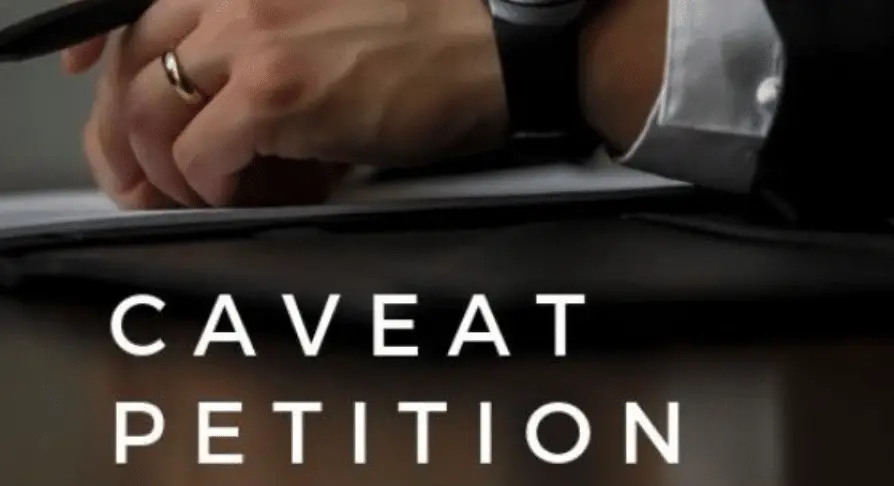Caveat Petition meaning: written request filed with the court suppose, A caveat petition is a legal document filed in a court of law to request that the court hear the petitioner’s side of the case before passing any orders or issuing any notices in a particular matter. The purpose of filing a caveat is to protect the petitioner’s interests and ensure that they are heard before any final decision is made in the matter.
Thank you for reading this post, don't forget to subscribe!In the Indian legal system, a caveat petition can be filed in any court, including the Supreme Court, to prevent any ex parte orders or judgments from being passed without the petitioner’s knowledge or presence. The filing of a caveat does not guarantee that the petitioner’s side will be heard, but it does ensure that the petitioner will be notified of any proceedings in the matter and has an opportunity to participate in the hearing.
It is important to note that a caveat petition must be filed before any proceedings take place in the matter and must be accompanied by a written petition stating the grounds for the caveat. Caveat Petition
(Opens in a new browser tab)

How to File caveat petition in the supreme court of india?
To file a caveat petition in the Supreme Court of India, you must follow these steps:
- Prepare a written petition in the prescribed format, stating the grounds on which the caveat is being filed.
- Pay the requisite court fee as specified by the Supreme Court registry.
- Submit the petition along with the court fee receipt to the registry of the Supreme Court of India.
- The registry will then verify the petition and list it for hearing before a bench of judges.
It is important to note that a caveat petition is filed to request the Supreme Court to hear the petitioner’s side of the case before passing any orders or issuing any notices in a particular matter. The filing of a caveat does not guarantee that the petitioner’s side will be heard, but it does ensure that the petitioner will be notified of any proceedings in the matter.
It is advisable to seek legal assistance to ensure that the caveat petition is properly drafted and filed in accordance with the rules and regulations of the Supreme Court of India. Taps9 Legal Services
(Opens in a new browser tab)
Caveat Petition Format?
In India, the format for a caveat petition typically includes the following information:
- Title of the case: The title of the case for which the caveat is being filed should be clearly mentioned at the top of the petition.
- Details of the petitioner: The petitioner’s name, address, and contact information should be provided.
- Details of the respondent: The respondent’s name, address, and contact information should be provided.
- Grounds for filing the caveat: A brief statement of the grounds on which the caveat is being filed should be included. This should explain why the petitioner believes that their interests are at risk and why the court should hear their side of the case before making a decision.
- Prayer: The petition should conclude with a prayer or request asking the court to hear the petitioner’s side of the case before taking any action.
- Signature: The petition should be signed by the petitioner or their authorized representative.
It is important to note that the format and content of a caveat petition may vary depending on the jurisdiction in which it is being filed. It is advisable to seek legal assistance to ensure that the petition is properly drafted and in compliance with the rules and regulations of the court in which it is being filed. Trademark Lawyer Kolkata
(Opens in a new browser tab)
When should I file a Caveat Petition in the supreme court?
A caveat petition should be filed in the Supreme Court of India when the petitioner believes that there is a possibility of a court decision being made without their knowledge or presence. The filing of a caveat petition is typically done as a precautionary measure to protect the petitioner’s interests and ensure that the court is aware of their position on a matter before a final decision is made.
It is advisable to file a caveat petition as soon as possible, especially if the petitioner believes that there is a risk of an ex parte order or judgment being passed without their knowledge or presence. The caveat petition must be filed before any proceedings take place in the matter and must be accompanied by a written petition stating the grounds for the caveat.
It is important to note that the filing of a caveat petition does not guarantee that the petitioner’s side will be heard, but it does ensure that the petitioner will be notified of any proceedings in the matter and has an opportunity to participate in the hearing. How Supreme Court Handle the Transfer Divorce Petition?
(Opens in a new browser tab)
Fee of Caveat Petition in India?
The court fee for filing a caveat petition in India varies depending on the court in which it is being filed. In general, the fee is a nominal amount, set by the court registry, which is paid by the petitioner at the time the petition is filed.
It is important to note that the court fee for filing a caveat petition may vary depending on the jurisdiction in which the petition is being filed, as well as the amount in dispute and the relief sought. Additionally, some courts may require an additional fee for service of the notice of the petition on the respondent.
To determine the exact court fee for filing a caveat petition, it is advisable to check with the registry of the court in which the petition is being filed, or to seek legal assistance. What is the need for a caveat petition in the supreme court of India?
(Opens in a new browser tab)
BOOK NOW!
GET 30-MIN FREE Consultancy. Available at Kolkata/ Delhi/ NCR.
Tapan Choudhury,
Advocate,
Mob- 9873628941
Email ID tapsash@gmail.com

File Caveat Petition in the Supreme Court of India within 24 hrs
Caveat Petitions In Supreme Court are filed by the Party in whose favour the order a has been passed in the High Court. Once Caveat is registered in the Supreme Court , the Caveator will be intimated about the filing of any Petition/Appeal that has been filed against him and will have the right to be served with a copy of the Petition /Appeal prior to the matter being listed before the Hon'ble Court . This gives the Caveator an opportunity to present his case on the very first date of hearing.